Creating a root cellar doesn’t require building or engineering skills; you only need a garbage can and some dirt.
With a little effort, you can easily construct your root cellar by burying a garbage can in the ground, an inexpensive and straightforward way to ensure you can store your food safely and securely.
Root cellars are a great way to store and preserve food for long periods. A root cellar is an excellent option for preppers looking for an effective way to store food for the long term.
You can create a root cellar with minimal effort to keep your food fresh and safe from spoilage, pests, and other threats.
This article will explore a novel way of making your root cellar out of a trash can and the benefits it can offer to preppers. With a little bit of elbow grease, you will have a functioning root cellar in no time.
What You Need
- Trash can or steel drum. Galvanized or stainless steel will work best.
- Plastic sheeting: This ensures that your drum has the longest possible lifespan. It will also help to keep pests out.
- Rocks or cinder blocks: These are optional but will help to create a raised shoulder, ensuring that runoff water does not enter your drum.
- Corrugated sheet or covering: I used a corrugated sheet covered with old pieces of shade net.
- Equipment: Shovel for digging the hole and a wheelbarrow to move rocks or cinder blocks. Maybe an axe to deal with stubborn tree roots.
Installation Process
1. Identify Site: I recommend finding a spot that never gets direct sun. Soft ground will help to dig the hole quickly. Do not select a low-lying area, as heavy rain could cause a temporary dam or large puddle to submerge your drum.
2. Place your trash can: Mark the outermost circumference of the drum and clean weeds for approximately 1-foot width. Then start digging the hole.
You want your trash can’s top 6 to 12 inches above the soil line. You will create a shoulder to ensure the trash can is entirely isolated, but raising the lid will ensure that your trash can does not become submerged.
Related: 5-Minutes DIY Tested Faraday Cage Out Of A Trash Can
I measure the depth I need to gain on the shovel’s handle. This way, I can keep track as I proceed.
3. Cover in plastic and put in the hole: I used an old paint drop sheet as a “tube” into which the drum goes. I then place it inside the hole.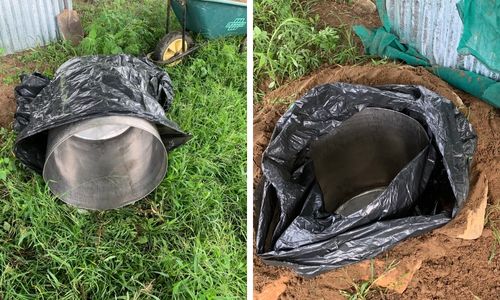
I cover the entire top of the drum, as this help to ensure that dirt doesn’t end up in the drum.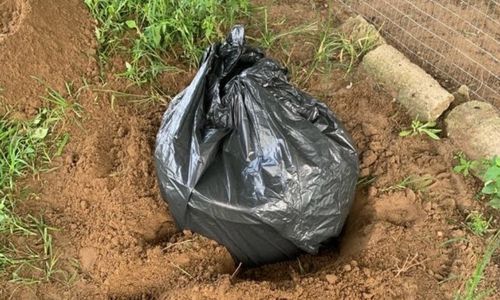
4. Lastly: Cover the trash can root cellar with corrugated sheeting and old shade netting to keep water away and reduce visibility.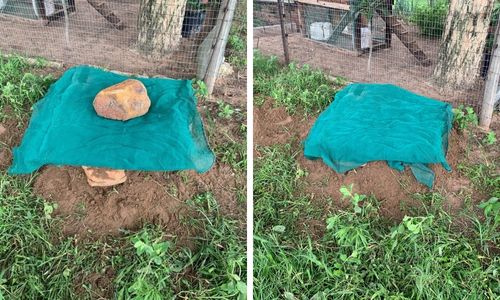
Ensuring that your trash can root cellar cannot be easily detected by intruders, particularly during a crisis, is crucial. If you want to build a larger root cellar that is still inconspicuous, here you can learn how to build an invisible root cellar.
Why Are Root Cellars Great?
Root cellars are a great way to store and preserve food. These underground rooms provide a dark environment that helps maintain food’s freshness and nutritional value.
By controlling the temperature and humidity in a root cellar, food perishability can be slowed down or even stopped altogether, making them an ideal choice for preppers who want to store food for long-term storage and emergency preparedness.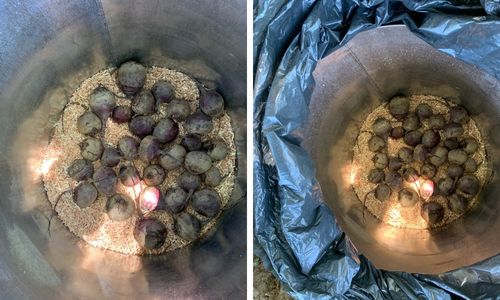
The darkness also helps protect the food from light, which can accelerate the breakdown of food nutrients.
Root cellars have been used for centuries to store and preserve food and are still an excellent way for preppers to ensure their food supplies remain edible for months or even years.
Typical items stored in a root cellar include fruits and vegetables, nuts, grains, canned goods, and dried meats. In addition, root cellars can store cheese, butter, eggs, beer, and wine.
Root cellars can keep your food fresh for an extended period with proper planning and upkeep.
Nevertheless, relying on root cellars is not the only option for storing your food without a fridge. Discover more about food preservation without electricity here.
Moisture Can Be An Issue
If you store fresh produce that has not been dried, moisture inside the drum could be a problem. Typically, ventilation within a root cellar is essential to maintain a proper temperature and humidity level.
Good air circulation helps prevent mold, mildew, and other spoilage organisms from developing on stored food. Without adequate ventilation, the air in a root cellar can become stale, creating a hospitable environment for these organisms.
Also, ventilation can help prevent sprouting root vegetables, like potatoes and onions.
Proper ventilation can be achieved by installing a small vent at the top of the root cellar or using a fan to move air in and out.
Drying The Air Without Ventilation
If you cannot provide any ventilation, then I suggest taking steps to dry the air. Adding completely dry wood shavings or newspaper inside a root cellar wick up moisture and dry the air.
You can also use straw or hay. Wood shavings can absorb moisture and make maintaining the desired humidity levels easier.
The newspaper also helps absorb water and can line surfaces or shelves inside the root cellar. Both materials are inexpensive, making them an excellent choice for preppers building a root cellar on a budget.
You may also like:
 How To Clear Your House When You Wake Up And You Think There Is An Intruder
How To Clear Your House When You Wake Up And You Think There Is An Intruder
The ‘Superweed’ That Saved Large Communities During The Great Depression (Video)
25 Things We Did as Kids That Would Get Someone Arrested Today

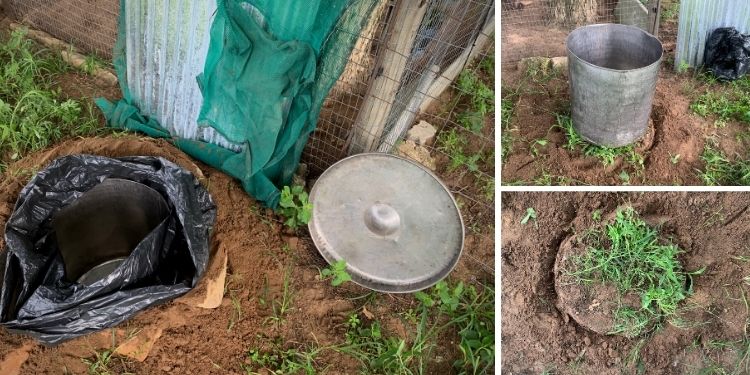




















so i guess you don’t live here in the Poconos cause you can’t dig a hole without a machine ….. way too many rocks
That is about the same in most locations, exceptions of good farmland soil.
Which the greedy corporations, government and activists are giving to China to appease the CCP. Take our farmland back.
Good idea for those that can dig large holes barring the rocks and clay soils.
Don’t forget that Bill Gates owns nearly all US Farmland now. (he is by far the largest farmland owner)
Plus I believe that he also owns farmland in other countries.
He is planning to genetically modify all livestock so we can eat “bio-engineered food, and so he can patent the food that he will “own”.
So get your livestock NOW, while you can still have God’s own creation for your food. (Make sure to get male and female, for breeding)
I would suggest an even better idea which is burying an unusable chest freezer in the backyard. Just be sure to remove the compressor before you do. A freezer offers a lot more room, is better insulated and often has a better seal.
Is this viable in Florida with the heat and humidity?
Depends on the depth buried and the insulation materials used. Florida does have sink holes around the State according to some U-Tub videos showing the cave-ins.
No, not even in Northern Florida. The soil temperature is too high year round.
Yeah, the info in this article resurfaces periodically. However, if you research root cellars, you’ll find that proper ventilation is key. You mention ventilation in this article, yet, nowhere do you indicate how to go about achieving it in your trash can scheme. Would be interesting to see how you would fix this.
The root cellar may work in certain climate seasons. That is a good thought about ventilation.
Could a metal trash can develop a lot of humidity from the vegetable material to cause water vapor leading to moldy conditions?
A root cellar has more open surface with air to have a better chance the raw or canned vegetables will have a better shelf life. As compared to a trash can with no ventilation to wick away the moisture buildup in a closed container.
Good idea, may need a little more design tweaking for long term storage.
Possibly the trash can method would be more short term in use.
What say others?
My thoughts on this are yes, the humidity could build without ventilation. And depending upon what’s stored, some ideas could ripen more quickly requiring you to check your trashcan (tc) stash more often.
For instance if you store apples, potatoes, and onions in your tc stash, apples give off ethylene, a gas which can cause ripe kng to occur more quickly. Your spuds may develop eyes faster or your onions could sprout sooner.
If you have even just one piece of fruit that has a small blemish, it can rot, ooze, and release it’s moisture to up the humidity inside.
As with a regular toit cellar, you’d want to check your items and use those that seem more ripe first.
To add ventilation, you could drill small holes in the can. Years ago, I made a compost bin from a trash can. A mouse needs a hole 1/4 inch to get In. I used 1/8 inch drill bit and put in a few more holes. Kept rodents out.
Not sure if worms would get in if it’s a tc stash with 2/8 inch holes. If that’s a concern, lining the can with hardware cloth after you drill the 1/8 inch holes would allow for ventilation.
You’d need to know where it was so if you have to clear snow away, you don’t waste time digging a little too far away.
People have also used old steel milk jugs the same way with good effect.
A few years ago, I tried storing carrots in a tc stash. Rather than putting it outside, I kept it in an unheated room. Wintertime temps in the space were 48-55°F, so a little higher than under the frost line which in my area runs 45-50°F, but close enough for me to try.
I kept the carrots in the plastic bag they came in. That bag had holes in it to allow for airflow.
Within a month, the carrots molded, and there was condensation inside my tc stash. I had placed two 5lb bags inside with nothing else.
We’re I to try this again, I considered storing the carrots in damp sand, but was concerned about condensation inside the tc stash. I also considered using dry sand. I have yet to carry out that experiment. The trash can was a standard 22 gallon galvanized can.
This would also be a viable EMP protected storage device.
That’s exactly what I have in my basement. Sealed with foil tape.
Don’t forget the EMP trash can method needs a layer of cardboard also. As describe in other EMP articles on this website.
Would the buried trash can with a cardboard layer also cause a condensation of moisture inside?
Why not a plastic rubbish can for a root cellar?
Will cave in?
I think that might be susceptible to rodents chewing their way through?
No more than a plastic Bag. Remember folks. This is a scaled down method to create one. The plastic bag or rubber trash can act as the same moisture insulator. If you can put a mental trash can inside a rubber trash can because it is available. That’s a good way too. Yes other methods can also apply if you have the mean$ then, by all means. Or build a root cellar if you can. But for a quick application- follow the reasons for doing such and apply the purposes for your climate.
It will disintegrate, eventually. Making it very short term.
Plus rodents can eat through plastic.
Not nice to give a thumbs down for a question!!!
Someone mentioned in other articles in the blog area, there are hackers or trolls leaving nonsense meaning words.
Can the monitor please resolve the problem?
Thank you.
if you’re wondering – a HVAC company is advertising
if you don’t like the info giving from this website then get off it….. don’t be a “D” they are just trying to help others and give awareness…… no information is all 100% correct. but if it can help another person out and possibly let them refine it, then why not share info to help other people out….. To damn many bitching Karen’s on here….. I take all advice in prepping and adapt it to my needs….. over 20 years of never depending on anyone……..
Dubie33:
Geeze, unbunch your panites…..
JohnD is referring to the nonsense one liners that find their way into the comments: (these are actual “comments”)
Well, darn. Claude must have gone back and deleted them, as I can’t find any right now…. But they look like someone put their fingers one over on the keyboard and it is gibberish, literally, similar to this:
yjrWiovTbtpeN , but the name shown is similar.
The trash can idea could work in certain climates like you said, but not in most northern states. I tried this 30 years ago in South Dakota, everything froze SOLID. So, know how cold the ground gets in your area to see if this storage method would work for you.
True. In a lot of areas you would have to go deeper to get below the frost line
Anyone know if the product called “Damp Rid” could be used inside the trash can to remove moisture without adding chemicals into the food?
Damp Rid is used in food grade buckets so that may help. Hadn’t thought of that.
Darn, I thought it was going to be because it will change the color of your blue hydrangas.
Interesting article, I’m wondering about a plastic 30-55 gallon container? I’ve seen them with bands that lock the top into place. Would that work with a 2-3″ PVC pipe chimney work?
Also, with the moisture issue, could you use vessicant packs, or would that just pull in moisture from the vent?
Something like a septic system neck and cap could be used to top it, but you’d have to modify it for ventilation. About the right diameter.
For ventilation I’d install some PVC pipe on both sides of the can so it could draw in fresh air and expel the gases.
Would have to put filters on end of pvc pipe or insect could get it. At least that’s my thought
I wonder if things sealed [and maybe o2 removed?] in Mylar bags would workout even without venting.
I know this could be adapted to storage of things you’d need in earthquake country like here in NW USA.
Good article – that means useful- thanks.
We were wondering the same thing. Bury a trash can filled with vacuumed sealed Mylar bags of foods. Would we need ventilation for that?
I’ve wondered if the trash can was big enough and in ground if a tornado came why couldn’t I climb in trash can if there was a vent?
if you bury the metal can a couple feet deep, as a root cellar would be, you can store freeze dried food inside that and canned food. You could also store home canned goods because the temperature will be more stable. Grew up in Mississippi and we had a storm shelter in the side of a ravine that was always cool. WE had the smoke shed and a shed were Grand ma put up her canned goods. The shelter was always cool inside and probably would have worked better than the little room off the carport. Just a bit of a stroll and climb up the ravine.
Has anyone successfully done the trashcan root cellar? I live in ne TN less than a mile from the NC border. If you saw the recent record breaking flood and devastation from Hurricane Helene, with the hospital flooding and the patients and employees being lifted to safety via Blackhawks, then you’ve seen my home.
The frost line is around 18″, the avg air temp through the winter is typically in the 30s and 40s during the day and then teens and 20s at night. I’ve seen it as low as -12° at night and then highs only in the teens. That usually only happens once or twice a season and just for 2-3 days each time.
We don’t have any ca$# or potential funds to install a proper cellar, nor are we physically able to undertake such a project right now. One of us is in a wheelchair permanently and the other is facing a second hip replacement along with a bulging disco and rotator cuff surgery after the hip is completely healed.
We just need something that is easily accessible and will be used to store 1 or 2 bushels of Irish potatoes and red sweet potatoes through the winter with minimal loss. What is the best method?